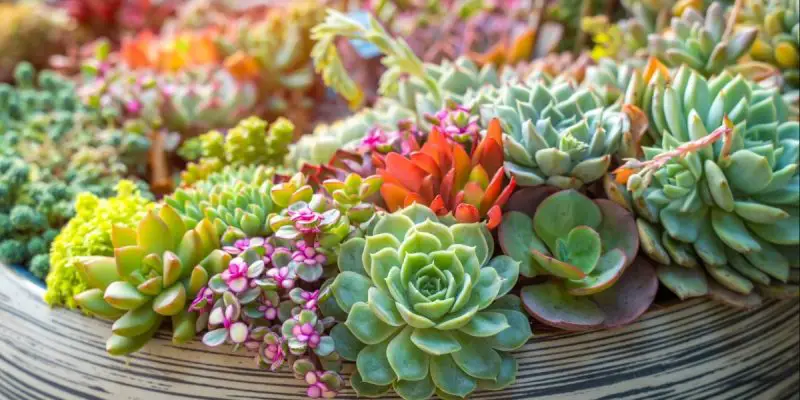Succulents are more than just trendy houseplants—they are living sculptures that bring life, texture, and charm to any space. With their thick, fleshy leaves and endless variety of shapes and colors, succulents are perfect for both new and experienced gardeners. They thrive in conditions that mimic their desert origins, requiring minimal water and plenty of sunlight. Yet, despite their reputation for being low-maintenance, succulents do need proper care to stay healthy and vibrant. Learning how to care for succulents the right way ensures your plants not only survive but truly thrive.
Understanding the needs of succulents allows you to unlock their full beauty and longevity. From choosing the right soil and pot to mastering watering techniques and sunlight exposure, every detail matters. When cared for properly, these resilient plants can live for many years, producing new growth, vivid colors, and even delicate blooms. This guide will teach you everything you need to know about keeping succulents happy—whether indoors on a sunny windowsill or outdoors in your garden. Once you master their rhythm, succulents will reward you with effortless elegance and enduring beauty.
Understanding Succulent Growth and Behavior

To care for succulents effectively, you first need to understand how they grow and behave. Succulents are plants adapted to survive in harsh, arid environments where water is scarce. Their thick, fleshy leaves, stems, or roots act as reservoirs, storing moisture to sustain them through long dry periods. Because of this adaptation, they prefer infrequent watering and dry soil conditions. Overwatering is one of the most common causes of failure with succulents, as their roots can quickly rot when left in standing water. Recognizing that these plants are built for drought helps you recreate their ideal environment at home.
Succulent growth patterns vary depending on the species, but most follow a seasonal rhythm. Many varieties grow actively during the spring and summer, producing new leaves and vibrant colors. In contrast, others, such as Haworthia or Aloe, slow down during these warmer months and grow during the cooler seasons. Understanding your plant’s specific growth cycle allows you to adjust watering and light accordingly. During the active phase, succulents need more sunlight and slightly more frequent watering, while during dormancy, they require minimal moisture and rest.
Another unique trait of succulents is their ability to respond visibly to stress. Changes in color, such as reddening or deepening hues, often indicate exposure to more sunlight rather than disease. This phenomenon, known as “sun stress,” enhances the plant’s natural beauty. Similarly, leggy or elongated growth suggests a lack of sufficient light. Observing these behaviors allows you to fine-tune their care and maintain compact, vibrant, and healthy plants. When you learn to read your succulent’s signals, you can provide precisely what it needs for optimal growth and long-term success.
Choosing the Right Soil for Succulents
The foundation of healthy succulent care begins with the right soil. Unlike typical houseplants, succulents require soil that drains quickly and prevents excess moisture from clinging to their roots. In their natural habitats—often deserts or rocky slopes—rainwater flows away rapidly, leaving only brief periods of dampness. To replicate these conditions at home, you need a light, porous soil mix that encourages airflow around the roots. Standard potting soil is usually too dense and retains too much water, which can lead to rot. Instead, use a specialized succulent or cactus mix designed to provide excellent drainage while holding just enough moisture for short-term absorption.
If you prefer to make your own mix, blend equal parts of potting soil, coarse sand, and perlite or pumice. The sand increases drainage, while perlite keeps the soil loose and aerated. Some gardeners add small gravel or crushed lava rock to enhance texture and further improve water flow. The goal is to create an environment where the roots can breathe freely, mimicking the plant’s native, gritty terrain. Always ensure your pots have drainage holes, as even the best soil mix cannot save a succulent sitting in stagnant water. Well-draining soil prevents root suffocation and supports steady, controlled moisture retention.
Soil quality also influences nutrient absorption. Poor or compacted soil limits access to essential minerals that promote vibrant color and growth. Replacing the soil every year or two refreshes the growing medium and prevents buildup of salts or residues from fertilizers. Healthy soil means healthy succulents—plants with firm leaves, vivid tones, and resilient roots. By understanding the importance of soil structure and composition, you give your succulents the perfect foundation to thrive and display their full natural beauty throughout every season.
Providing Proper Light for Succulents
Light is one of the most crucial factors in keeping succulents healthy and beautiful. These plants evolved in sunny, open environments, so they thrive in bright light and need several hours of it each day. Most succulents require at least six hours of indirect or filtered sunlight to maintain their compact shape and vivid color. Without enough light, they begin to stretch and lose their characteristic form—a condition known as etiolation. In this state, the plant grows tall and thin as it searches for more light, weakening its structure and dulling its color. Proper lighting not only prevents this but also enhances the rich tones and patterns that make succulents so appealing.
For indoor succulents, location makes all the difference. Place them near a south- or east-facing window where they can soak up bright, indirect light. Rotate the pots every few days to ensure even exposure and prevent leaning toward one direction. If natural sunlight is limited, especially during winter months, use a grow light designed for succulents. LED grow lights with a full spectrum mimic natural sunlight, helping the plants photosynthesize efficiently. Keep the light on for 10 to 14 hours daily to maintain healthy growth without overheating the leaves.
Outdoor succulents need similar attention, especially when transitioning between indoor and outdoor environments. Gradually introduce them to full sunlight to prevent sunburn, as intense rays can scorch the leaves if the plant isn’t acclimated. Once adjusted, succulents thrive in bright conditions, often developing stronger colors and tighter leaf formations. Observing how your plants respond to light helps you find their ideal placement. With the right amount of sun exposure, your succulents will stay compact, colorful, and full of life all year long.
Watering Succulents the Right Way
Mastering the art of watering is the key to keeping succulents thriving. Unlike most plants that prefer consistently moist soil, succulents are designed to survive drought by storing water in their leaves and stems. Overwatering is the most common mistake gardeners make, as it can quickly lead to root rot. The correct approach is to water deeply but infrequently, allowing the soil to dry completely between waterings. This cycle mimics the natural environment of succulents, where rain comes rarely but in short, heavy bursts. Always use pots with drainage holes to allow excess water to escape, preventing the roots from sitting in damp soil for too long.
The frequency of watering depends on several factors, including temperature, light exposure, and humidity. During the active growing seasons of spring and summer, succulents may need watering every one to two weeks. In fall and winter, when many species go dormant, watering should be reduced to once a month or less. It’s best to check the soil before watering—if the top two inches feel dry, it’s time to hydrate. When watering, pour directly at the base until water drains from the bottom of the pot. Avoid misting, as it encourages weak, shallow roots instead of deep, strong ones.
Different environments require small adjustments in watering habits. Indoor succulents often need less water than outdoor ones, as they are protected from evaporation. Conversely, succulents in hot, dry climates may need slightly more frequent watering. Over time, you’ll learn to read the signs: plump leaves mean well-hydrated plants, while wrinkled or soft leaves signal thirst. Consistent, mindful watering keeps your succulents balanced—neither too dry nor too wet—allowing them to flourish with strong roots, firm leaves, and radiant color.
Choosing the Right Container for Succulents
The container you choose for your succulents plays a major role in their health and longevity. Succulents prefer containers that allow their roots to breathe and prevent water from accumulating at the bottom. The most important feature of any container is proper drainage. Without it, even a small amount of excess water can lead to root rot. Clay or terracotta pots are often the best choice because they are porous, helping excess moisture evaporate naturally. Plastic or ceramic pots without drainage holes should be avoided unless you are extremely careful with watering. The right container doesn’t just protect the roots—it also complements the plant’s beauty, enhancing its display.
Container size also affects how succulents grow. A pot that’s too large retains water longer and increases the risk of overwatering, while a pot that’s too small can restrict root expansion. The ideal pot should be only slightly larger than the bulb or root system of the succulent. This balance encourages steady growth and prevents the soil from staying wet for extended periods. Shape matters too—shallow, wide containers are perfect for low-growing succulents, while deeper pots suit species with larger root systems like Aloe or Agave. Choosing the right container structure ensures each plant thrives in its natural form.
Beyond functionality, container material and color can influence temperature and plant performance. Dark-colored pots absorb heat quickly, which can dry out soil faster in direct sunlight, while lighter pots keep roots cooler. Always consider the plant’s growing environment before deciding on a pot. Combining aesthetics with practicality creates the ideal growing conditions for healthy succulents. With the right container, you not only prevent common issues like rot or stress but also highlight the unique shapes and colors that make succulents so captivating.
Fertilizing and Feeding Succulents
While succulents are known for thriving in poor, sandy soils, they still benefit greatly from the right kind of fertilization. Feeding your succulents helps them maintain vibrant colors, firm leaves, and steady growth throughout the year. However, too much fertilizer can do more harm than good, leading to soft, leggy growth or nutrient burn. The key is moderation—succulents prefer light, diluted feeding during their active growing season, which typically occurs in spring and summer. During their dormant period in fall and winter, feeding should be stopped entirely. This natural rest phase allows the plants to recover and prepare for the next cycle of growth.
The best fertilizers for succulents are balanced or low-nitrogen blends, such as a 10-10-10 or 5-10-10 formula. Nitrogen promotes leafy growth, but too much can make the plant soft and prone to disease. A water-soluble fertilizer diluted to half or quarter strength works perfectly. Apply it once every four to six weeks during the growing season. Pour the solution directly onto the soil, avoiding the leaves to prevent chemical damage. For organic gardeners, options like compost tea, worm castings, or fish emulsion provide gentle nutrition while improving soil structure and microbial activity. These natural alternatives support long-term soil health and consistent growth.
Timing and consistency are everything in succulent feeding. Fertilizing right after watering ensures nutrients reach the roots evenly without causing burn. Over time, you’ll notice firmer leaves, deeper color, and stronger roots—all signs of a well-nourished plant. Remember, succulents evolved in nutrient-poor environments, so they need only light feeding to thrive. A thoughtful approach to fertilization keeps your succulents balanced, resilient, and glowing with natural beauty season after season.
Common Mistakes When Caring for Succulents
Overwatering and Poor Drainage
Overwatering remains the number one cause of succulent failure, especially among beginners. Because succulents look sturdy, many assume they need regular watering like other houseplants. In truth, succulents store water in their fleshy leaves, stems, and roots, making them extremely sensitive to excess moisture. When the soil stays damp for too long, oxygen levels drop and roots begin to rot. The plant’s leaves then turn soft, translucent, or mushy—clear warning signs that it has been overwatered. Even a few days of standing water in the pot can trigger irreversible damage to the root system.
To prevent this, always use well-draining soil and containers with holes that allow water to escape freely. Water deeply but infrequently, waiting until the soil is completely dry before the next watering. Avoid misting, as this encourages shallow roots and fungal growth. If a plant shows early signs of overwatering, remove it from wet soil, trim damaged roots, and replant it in a dry mix. Learning to recognize your succulent’s hydration needs is vital. It’s far easier to revive a thirsty plant than to save one drowning in water. Proper drainage and patience are the keys to long-lasting, healthy succulents.
Insufficient Light
Insufficient light is another major reason succulents lose their compact shape and vibrant color. These sun-loving plants rely on bright, indirect sunlight to stay healthy. When light levels drop, succulents stretch upward in search of brightness, resulting in long, weak stems and faded leaves. This process, known as etiolation, not only alters the plant’s shape but also weakens its overall structure. Lack of light also reduces pigment production, causing once-colorful varieties to turn pale green or grayish. Without enough sunlight, even hardy indoor succulents can struggle to photosynthesize efficiently and may stop growing altogether.
To correct this, place your succulents in a bright location such as a south-facing window or under grow lights that provide a full spectrum of light. If moving a plant outdoors, introduce it gradually to stronger sunlight to prevent leaf burn. Rotate pots weekly so all sides receive even exposure, and monitor for signs of stress. Healthy succulents should appear compact with firm, vibrant leaves. Providing consistent light not only enhances color but also strengthens root systems and improves flowering. Balanced lighting mimics their natural environment, helping your succulents thrive with the energy and brightness they need.
Ignoring Seasonal Changes
Ignoring the seasonal rhythms of succulents is a common mistake that affects long-term health and blooming potential. Succulents naturally adapt to changing temperatures and daylight, entering periods of growth and rest throughout the year. During spring and summer, most species grow actively, requiring more sunlight, slightly more water, and occasional fertilization. However, as autumn arrives, many succulents begin slowing down and eventually enter dormancy. Continuing heavy watering or feeding during this resting phase can cause root rot, soft leaves, and poor regrowth in the following season. Understanding this natural pattern allows you to align care with the plant’s internal clock.
During dormancy, reduce watering dramatically and stop fertilizing altogether. Allow the soil to dry completely between waterings, and place the plant in a cooler area with bright, indirect light. This rest period helps the succulent conserve energy and prepare for its next growth cycle. Once warmer weather returns, gradually resume regular care. Adjusting your routine to match seasonal changes keeps succulents vigorous, resilient, and ready to bloom again. Respecting nature’s rhythm not only prevents common health problems but also leads to stronger, longer-living plants that showcase their beauty year after year.
Propagating Succulents Successfully
Propagating succulents is one of the most enjoyable and rewarding parts of growing these resilient plants. It allows gardeners to expand their collection effortlessly while appreciating the unique way succulents regenerate. Propagation can be done through leaves, cuttings, or offsets, depending on the species. The process begins by selecting a healthy parent plant with mature, firm leaves or stems. For leaf propagation, gently twist off a single leaf from the stem, ensuring a clean break. Allow the leaf or cutting to dry for a few days until the end forms a callus—this prevents rotting once placed on soil. This simple step is the foundation of successful propagation and mimics how succulents naturally reproduce in the wild.
Once the cuttings have callused, place them on well-draining soil without burying them deeply. Mist the soil lightly every few days to maintain humidity, but avoid overwatering. Within a few weeks, tiny roots and baby plants will begin to form. Bright, indirect light supports this early stage of development. As the new plants grow, gradually increase sunlight exposure and reduce misting. Once they are strong enough, transplant them into their own small containers with succulent mix. The key is patience—growth may seem slow at first, but each cutting eventually develops into a full, independent plant.
Propagation not only saves money but also strengthens your understanding of how succulents grow. Each new plant is a clone of its parent, inheriting its color, shape, and resilience. Watching them develop from a single leaf into a thriving succulent is both fascinating and satisfying. Regular propagation also rejuvenates older plants by encouraging fresh growth. With careful attention to timing, moisture, and light, anyone can master the art of succulent propagation and create a beautiful, expanding garden full of vibrant, living treasures.
Post-Propagation Care and Growth Tips
After successful propagation, the real work begins—helping your new succulents grow strong and healthy. Young plants are delicate and require slightly different care than mature ones. At this stage, it’s important to provide consistent moisture without overwatering. Newly rooted succulents don’t have the same water-storing ability as adult plants, so they need gentle hydration. Lightly water the soil whenever the top layer feels dry, but ensure the container drains freely. Over time, reduce watering frequency as the plants develop thicker leaves. Keep them in bright, indirect sunlight, as direct sun can scorch their tender surfaces. A steady environment with warmth and airflow encourages smooth root development and prevents fungal growth.
Once your propagated succulents establish a stable root system, they begin to grow more vigorously. Gradually introduce them to more sunlight by moving them closer to a bright window or into partial outdoor light. Avoid sudden exposure to harsh midday sun, which can shock or burn the leaves. This gradual adjustment strengthens the plants and helps them produce compact, colorful growth. During this period, fertilization should be minimal. A diluted, balanced liquid fertilizer once every six weeks provides all the nutrients young succulents need without overwhelming their roots.
Patience is key to successful post-propagation care. New succulents may take several months to mature and show their full color and form. Continue monitoring their growth and adjusting watering and light as needed. If any leaves shrivel or fall, it’s normal—energy is being redirected into new development. With steady care, these propagated plants will soon match the resilience and beauty of their parent succulents. Supporting this transition phase ensures a thriving, ever-expanding collection that reflects both your skill and dedication as a grower.
Reviving Unhealthy or Dying Succulents
Even the most careful gardeners occasionally face unhealthy or struggling succulents. Luckily, these hardy plants are remarkably resilient and can often recover with the right approach. The first step in revival is identifying the problem. Common symptoms include soft, mushy leaves from overwatering, shriveled leaves from dehydration, or pale, elongated growth from lack of light. Examine the roots by gently removing the plant from its pot. Healthy roots should appear white and firm, while brown or black roots indicate rot. If root rot is present, trim away all affected parts with sterilized scissors before repotting the plant in fresh, dry, well-draining soil. This clean start gives the succulent a chance to rebuild and heal.
Once the plant has been repotted, adjust watering habits to encourage recovery. Water sparingly and only when the soil feels completely dry. Provide bright, indirect sunlight to stimulate photosynthesis without causing additional stress. For dehydrated plants, water thoroughly but allow full drainage—succulents often plump back up within a few days. Avoid fertilizing immediately, as weakened plants cannot absorb nutrients effectively. Instead, focus on restoring balance through proper light, airflow, and temperature. With consistent care, even succulents that seem hopeless can bounce back to life.
If your succulent shows signs of stretching or fading, it’s likely craving more light. Move it closer to a sunny window or under a grow light for a few hours daily. Regularly rotate the pot to ensure even exposure. In time, new compact growth will replace stretched leaves. Reviving a sick or dying succulent requires patience, but once it recovers, the plant often grows stronger than before. Proper care, observation, and quick action are the keys to turning a struggling succulent into a thriving one again.
Seasonal Succulent Care Guide
Caring for succulents throughout the year means adjusting your routine to match seasonal changes. Each season affects how much light, water, and warmth your succulents need. In spring, most succulents begin their active growth phase. This is the perfect time to increase watering slightly, refresh soil, and provide extra sunlight. Temperatures are mild, and longer days promote faster leaf and root development. You can also start fertilizing with a diluted, balanced formula every four to six weeks to encourage strong, compact growth. Spring is also ideal for repotting or propagation, as plants recover quickly from root disturbance.
Summer brings more intense light and higher temperatures, which can both help and harm succulents. Outdoor plants thrive in bright conditions but may need protection from scorching midday sun. Provide light shade or move pots to a spot with filtered sunlight to prevent leaf burn. Increase watering frequency slightly if the weather is very dry, but always let the soil dry completely between waterings. Indoor succulents should be kept near windows with good airflow to avoid heat buildup. As long as you balance sun exposure and moisture, summer is the season when succulents display their most vivid colors.
In fall and winter, growth slows as many succulents enter dormancy. Reduce watering to once a month or less and stop fertilizing until spring. Place the plants in a bright location to help them retain color and shape. Keep temperatures above 50°F to prevent cold damage, especially for tropical varieties. Some succulents, like Haworthia and Aloe, continue growing during the cooler months—these can tolerate slightly more water. Adjusting care seasonally allows your plants to follow their natural rhythm. Understanding these cycles ensures your succulents stay vibrant, healthy, and ready to burst into new growth every year.
Frequently Asked Questions About Succulent Care
How Often Should I Water My Succulents?
Water succulents only when the soil is completely dry. Depending on the climate, this usually means once every one to two weeks in summer and once a month in winter. Overwatering is far more harmful than letting them stay dry for a short period.
Can Succulents Grow Without Sunlight?
Succulents cannot thrive without light. They need at least six hours of bright, indirect sunlight daily. If grown indoors, place them near a sunny window or use a grow light. Without enough light, succulents become pale, weak, and leggy over time.
Why Are My Succulent Leaves Falling Off?
Falling leaves often signal improper watering or sudden temperature changes. Too much moisture causes rot, while extreme dryness or cold shocks the plant. Check the roots and soil condition, then adjust your watering schedule and environment to stabilize growth.
Do Succulents Need Fertilizer?
Yes, but sparingly. Succulents only need light feeding during their active growing season, usually spring and summer. Use a diluted, balanced fertilizer once a month. Avoid fertilizing during dormancy, as the plant rests and cannot absorb nutrients efficiently.
Can I Keep Succulents Outdoors Year-Round?
That depends on your climate. Most succulents tolerate warm, dry conditions but can’t survive freezing temperatures. In cold regions, bring them indoors before frost. Outdoor succulents thrive in well-drained soil, bright light, and moderate watering throughout the warm months.
Conclusion
Caring for succulents is both an art and a practice of patience. These resilient plants ask for little but reward you with stunning beauty when treated right. By mastering sunlight, soil, watering, and seasonal care, you create the perfect environment for them to thrive. Each leaf and stem tells a story of balance and endurance, reminding us that strength often grows from simplicity. With thoughtful attention and consistency, your succulents will flourish year after year—vivid, elegant, and full of life, turning any space into a serene, living masterpiece.






